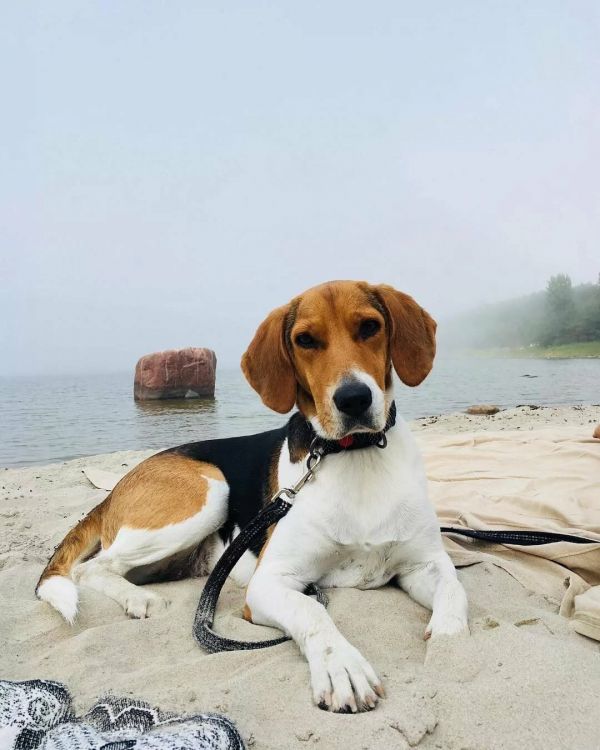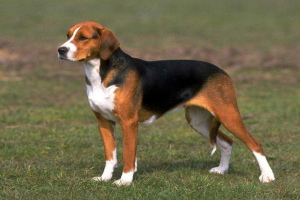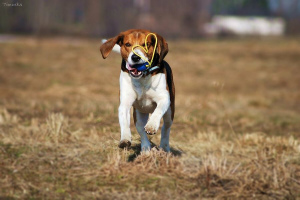Estonian Hound
Fit for allergics: No
Name of the breed: Estonian Hound
For families with children: Yes
Difficulty of care: No
Dog guard: No
Guide-dog: No
Ability to train: Yes
 Interesting Facts
Interesting Facts
- Puppies of this breed quickly grow up.
- Already at the age of six months they are able to start hunting.

- There are cases when only a seven-month-old puppy received diplomas and awards for his amazing achievements in hunting.
- To overdo it with loads is not worth it. Despite the early adulthood, this may affect the health of the pet in the future.
_120x126.jpg) Estonian Hound breed history
Estonian Hound breed history
Sergey Smelkov laid the foundation for the birth of a new breed. There was a need for a time gap between two world wars. The fact is that in Estonia there was a serious threat of a decrease in the roe deer population. To combat this, hunting with dogs whose height exceeded 45 cm was prohibited.
There was an urgent need to bring out a stunted, strong, sonorous, fast dog. Subsequently, this marked the history of the Estonian hound.
Various local four-legged hounds suitable for such hunting were selected for breeding work. Beagle’s blood was mixed with them, as an excellent short-height catcher. Due to its insufficient volume and rather weak paws, the Swiss hound was brought to work.
The result was a pet, which today can be observed mainly in Russia, Finland. This breed is not recognized by FCI.
_120x127.jpg) Description of the Estonian Hound
Description of the Estonian Hound
When looking at the caudate, many confuse it with the Beagle. They really have a lot of similarities. However, there are significant differences. So, in the description of the Estonian hound, special emphasis is placed on the fact that she is more elegant, not so stocky. She is characterized by a slender, athletic body. It is not tall, but elongated. The back is straight. A tail should not rise above its line. It has the shape of a saber, thick at the base, thinner at the tip.
The dog’s neck is strong. The head has a rectangular shape. The transition from the skull to the muzzle is visible, but not too sharply. The superciliary arches are also noticeable. Eyes slightly slanting, dark in color. Ears are hanging, thin, with rounded tips.
Scissor bite.
The limbs are muscular and slender. Seen from the side, they look straight and parallel to each other.
The coat is almost completely devoid of undercoat. The outer hair itself is straight, stiff and short. The standard color is black-pied with red spots. Paws and tail should be white.
The character of the Estonian hound
These four-legged have a very flexible disposition. In the process of hunting, they seem to turn off, completely concentrating on their object. They can track him for hours and even days. They are very focused, attentive. Seeing the desired booty, they become very gambling, cunning, going to great lengths to achieve their goal.
Despite such violent activity during the hunt, at home it is absolutely submissive, affectionate favorite. He loves his whole family, but the owner, of course, is especially strong. With calm and acceptance, he treats children, he is ready to accept their various tricks and leprosy.
Other pets can have problems, but only if they get to know each other as adults.
_120x129.jpg) Content of the Estonian Hound
Content of the Estonian Hound
Despite the fact that the pet has a working orientation, he will be able to live in the apartment. It does not require too much space, your constant attention. But this does not mean that you have the right to neglect his physical activity. In order for the pet to have the opportunity to “walk up” he must have at least two walks per day. And not for 10 minutes, but ideally an hour or more.
Coat is not endowed with undercoat. Due to this, you do not need to worry every day about combing it.
Other standard care procedures are also required during the maintenance of the Estonian Hound. This is brushing your teeth, ears, claws, rubbing your eyes.
_120x106.png) How to feed the Estonian hound?
How to feed the Estonian hound?
Owners note that their pets are not picky about food. However, this does not give you a signal to feed with food from your own table, cheap feeds and canned goods, sausages in the bite with bread. This dog is categorically not suitable.
You need to feed the Estonian hound with high-calorie food so that he has the strength to hunt. Both dry feeds and dishes prepared by you are suitable. The main thing is to carefully balance his daily diet, diversify, saturate with all the necessary useful elements.
_120x120.png) Hunting with the Estonian Hound
Hunting with the Estonian Hound
Any dog, let alone a working one, needs to be raised in a timely manner. Either tips from the Internet or professional dog handlers will help you do this wisely. The main thing is the end result.
Education should begin from a very early age. These tails are very smart and quick-witted. There should not be any problems with training. Use the promotion method and your trusting relationship to achieve maximum results.
Hunting with an Estonian hound gives the hunter great pleasure. From childhood, they learn the skills of orienting in space, tracking game, pursuit, attack.
Do you like this breed? Choose a suitable offer on PetGlobals.com!
We collected the advertisements from all around the world and placed them on international platform for buying/selling pets. Only on our Web-site you can find the most rare breeds of cats and dogs!
Advertisements for buying/selling cats
Advertisements for buying/selling dogs
With help of PetGlobals.com your future pet is closer to you!
 Select language
Select language 







.png)
